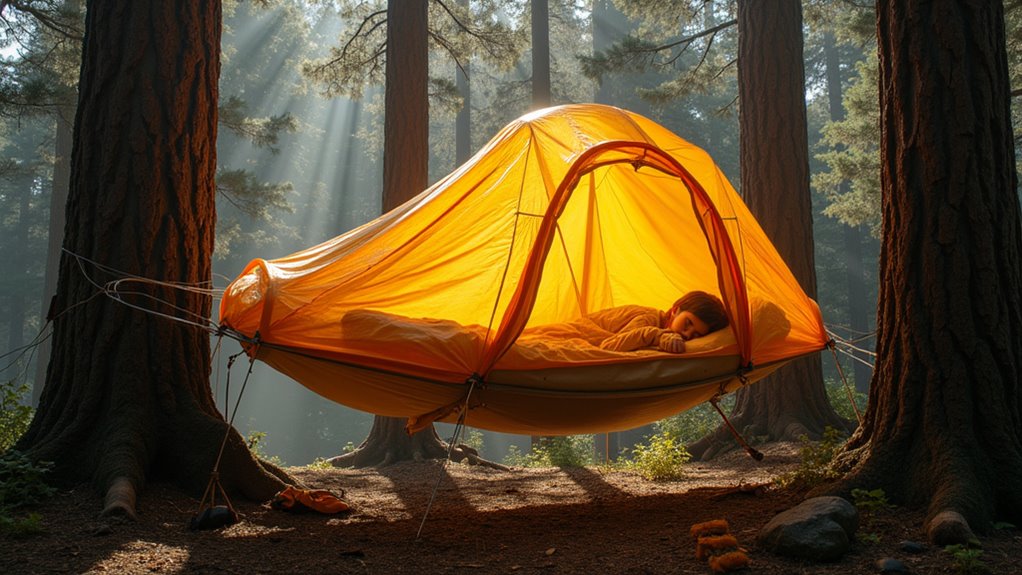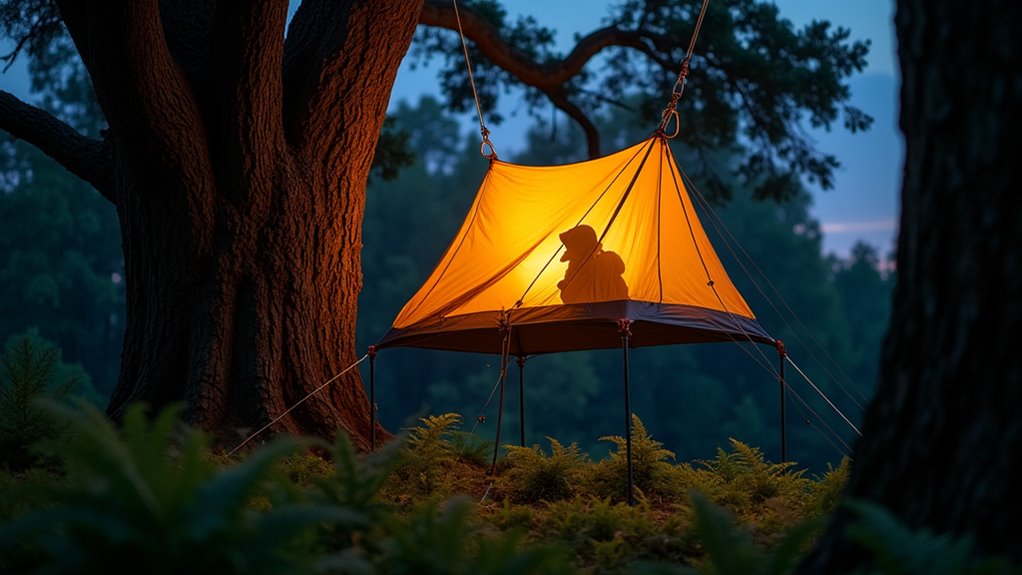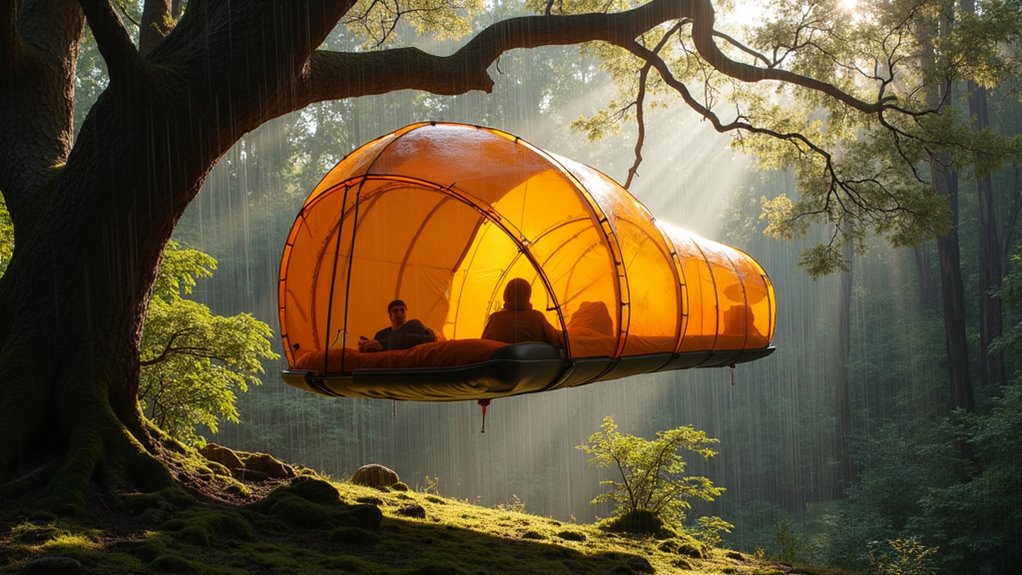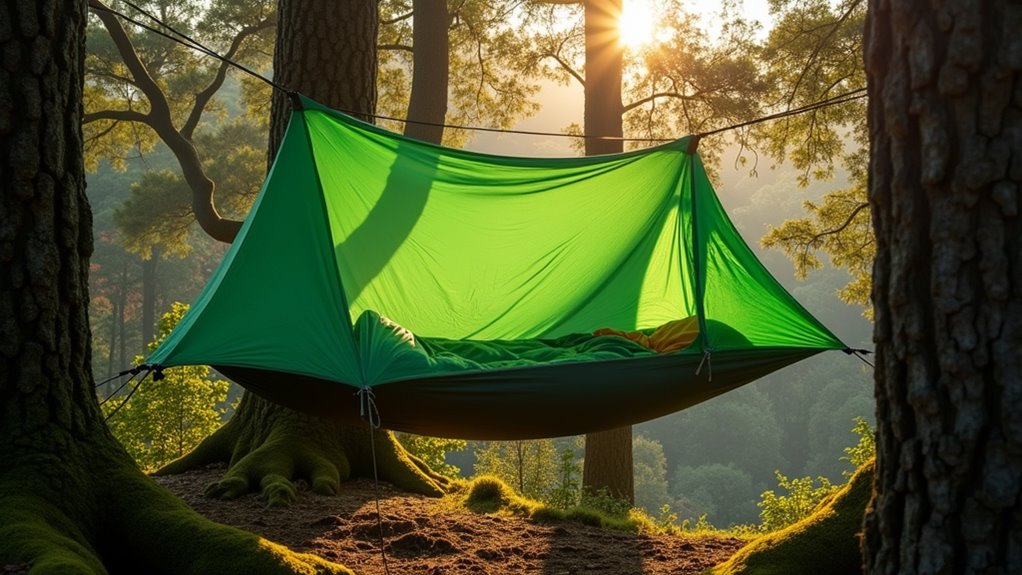Physical Address
304 North Cardinal St.
Dorchester Center, MA 02124
Physical Address
304 North Cardinal St.
Dorchester Center, MA 02124

Keep your camping adventures grounded? Think again - chrysalis tents let you sleep suspended in trees, but there's a catch.
You’ve probably never considered sleeping suspended fifteen feet off the ground, but tree camping in a chrysalis tent might change how you think about outdoor adventures. These cocoon-like shelters cost less than you’d expect and eliminate the need for expensive sleeping pads or level ground. You’ll skip the usual campsite fees while experiencing something most campers never try. Before you dismiss this as too complicated or risky, there’s more to these aerial shelters than meets the eye.

While traditional tents anchor you to the ground with stakes and guy-lines, chrysalis tents suspend you among the branches like a cocoon. You’ll find they’re basically hammock-tent hybrids that wrap around you completely, protecting from weather while keeping you elevated.
Chrysalis tents elevate you off the ground like a protective cocoon suspended between trees.
Unlike ground tents, you won’t need expensive sleeping pads since the tent’s design provides insulation from below. You’ll also skip the hassle of finding level ground or clearing rocks and roots.
Setup’s simpler too – just two anchor points between sturdy trees.
The downside? You’re limited to areas with appropriate trees spaced 12-15 feet apart. They’re also pricier than basic ground tents, starting around $200. However, you’ll save money on camping fees since many dispersed camping areas allow tree camping for free.
For tent camping beginners, chrysalis tents eliminate many common setup mistakes since you don’t need to worry about staking or finding perfectly flat terrain.
Beyond the chrysalis tent itself, you’ll need specific gear to make tree camping work safely and comfortably. Start with sturdy climbing rope rated for your weight plus gear. You’ll want tree straps to protect bark and distribute weight evenly. A reliable harness is non-negotiable for safety during setup and entry.
Don’t forget a headlamp for hands-free visibility and carabiners for secure connections. Pack a lightweight sleeping bag rated for expected temperatures. Consider a compact camping pad for extra insulation and comfort.
Budget-friendly alternatives include using paracord instead of expensive climbing rope for lighter loads. Check thrift stores for gently used harnesses. Many chrysalis tent manufacturers offer starter kits that bundle essential hardware at discounted prices, making your tree camping adventure more affordable. When selecting your equipment, remember that understanding the essentials of camping gear will help you make informed decisions about what’s truly necessary versus optional for your tree camping setup.

Since your safety depends entirely on the trees you choose, start by looking for healthy hardwoods like oak, maple, or hickory that are at least 12 inches in diameter. You’ll want trees spaced 8-15 feet apart with sturdy, living branches free from rot or damage.
Scout your location during daylight and consider these key factors:
Test each tree by pushing against it firmly. Dead branches, loose bark, or any movement means you’ll need different trees.
Your budget-friendly adventure shouldn’t compromise safety. Alpine, Wyoming offers excellent tree camping opportunities with both adventure camping and relaxing options for your suspended getaway.
When you’re sleeping 15 feet off the ground, understanding weight limits isn’t just about comfort—it’s about survival. Most tree tents support 400-880 pounds, but you’ll want to stay well below maximum capacity.
Factor in your body weight, gear, sleeping bag, and any movement during sleep.
Check your tent’s specifications carefully—cheaper models often have lower limits. Inspect straps and anchor points before each use, looking for fraying or wear. Replace webbing annually if you’re a frequent camper.
Don’t ignore tree health either. Dead branches, diseased bark, or unstable trees spell disaster. Test your setup at ground level first, then gradually increase height as you gain confidence.
Always carry a headlamp and know your emergency descent plan before dark. Elevated camping also reduces your exposure to ground-dwelling creatures, which means fewer insect bites to worry about during the night.

While you’re suspended among the branches, your pod-style tent becomes your only barrier against rain, wind, and temperature swings. You’ll need reliable weather protection without breaking the bank.
Most budget-friendly chrysalis tents offer these essential comfort features:
You don’t need expensive bells and whistles. Focus on tents with proven waterproofing, adequate ventilation, and sturdy zippers.
Many affordable models under $200 provide excellent weather protection. Check user reviews specifically mentioning rain performance before purchasing.
Your comfort depends on choosing practical features over flashy extras. Consider planning family camping activities to make your tree camping adventure more engaging for everyone involved.
Each model offers different strengths, so match your choice to your specific camping style and budget. For those seeking a truly personalized experience, consider exploring options to design custom tents that perfectly match your unique tree camping requirements and preferences.

Before you venture into the canopy for your inaugural tree camping adventure, you’ll want to scout potential locations during daylight hours. Look for sturdy trees with thick, healthy branches that can support your weight plus gear. Don’t forget to check local regulations—some parks prohibit tree camping entirely.
Your preparation checklist should include:
Start with a single night close to home. You’ll learn valuable lessons without committing to an expensive multi-day expedition in unfamiliar territory. Minnesota offers exceptional opportunities for tree camping with its diverse forest landscapes and numerous camping locations throughout the state.
After you’ve enjoyed your first night suspended among the branches, you’ll need to establish a routine that keeps your chrysalis tent functioning safely for years to come.
Check all straps and buckles before each setup – frayed webbing can fail catastrophically. Clean mud and debris from zippers using an old toothbrush and mild soap. Don’t machine wash your tent; instead, spot-clean with gentle detergent and air-dry completely before packing.
Store your shelter loosely stuffed rather than tightly compressed to prevent fabric damage. Inspect anchor points quarterly for wear patterns. Replace carabiners showing gate play or corrosion – they’re cheaper than hospital bills.
UV exposure weakens materials, so avoid prolonged sun exposure during storage. Keep repair patches handy for quick trail fixes. Following these tent cleaning tips will ensure your suspended shelter remains in pristine condition for countless adventures overhead.
You’ll trade your flat tent’s ordinary ground-level view for an extraordinary treetop sanctuary, swapping dirt and rocks for swaying branches and starlit canopies. While traditional camping keeps you earthbound, tree camping elevates your entire adventure—literally. Don’t let budget concerns ground your dreams; many quality chrysalis tents cost less than premium ground tents. You’re not just camping anymore; you’re floating in nature’s penthouse. Pack light, climb high, and transform your next outdoor escape into an unforgettable aerial experience.